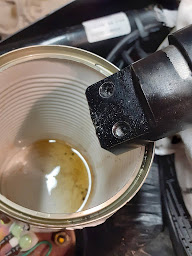Not long after I got the bike and before this blog began I got the notion to fit LED day riding lamps (DRL). These lamps replace the indicators are white all the time until you switch on an indicator then the amber lamp flashes, returning to white when the indicator is switched off. More about that in a different blog. In the DRL kit was a pair of LED "bulbs" to replace the side lights next to the headlamps. Once installed LED side lights and the DRLs really showed up the main head lights as milky white instead of the crystal white of the LEDs. Something had to be done about that.

I bought a set of NovSight N9/7 LED headlights. Note to self, look really hard fo rth einstructions. I did not find them until I had finished the fitting and the instructions had a useful piece of information. More on that later.
I had replaced the new radiator but had purposely not replaced the forks. This gave me good access to the back of the head lights.
Removing the existing headlights was not too tricky. Remove the rubber cover and flick out the sprung bulb retainer. One electrical connector would not come free from the back of the bulb and I ended up destroying the existing bulb. The new LEDs better fit now!
Refitting the LEDs.....ahem. This was a right royal pain in the behind. Usually one would presents the bulb to the front of the rubber dust cover and the pronges of the bulb simply push through the rubber. The flange behind bulb locates into the headlight housing and provides a surface for the retaining clip to press upon. That 's normal bulbs work.

LEDs, however, have a huge heat sink, fan unit and ballast resistor then the normal locating flange. This means the hole in the dust rubber is to small to for either fan end or the flange end of the LED. The fan end was the smaller of the two ends. I was able to feed the ballast unit through the hole. The fan would just not go through. I also had to be careful not to damage the LEDs. When my patience was worn thin I decide to make a small cut in the hole of the dust rubber. The cut got bigger as the fan was forced throught the hole. In the end the rubber sat correctly but because it was between the fan and flange there was not much room to fit the retaining clip. The bulb located quickly and correctly into the back o fthe headlight housing but it several attempts to get the spring clip located properly because the rubber was inthe way. The rubber seated into it location. The question is will be be weatherproof. Only time will tell. The long tail with the ballast was zip tied to the fairing supports and the electrical connector plugged in. The second side was a bit easier as I had already tackled one side. As usual it was on the left handed side.
The headlight switch was was flicked......bloody hell they are bright. I was pleasantly surprised to find there was very little lag when selecting on, high, low and flash switches. When I get the bike on its wheels and outside I will have to be careful with aiming the headlights. I could blind someone with those things.
Here's the rub. I found the fitting instructions in a daft place in the presentaton box. Reading the instruction showed the flange could be unscrewed to allow the bulb to slide through the hole in the dust rubber. The flange is then refitted to the LED...doh and doh again.







































